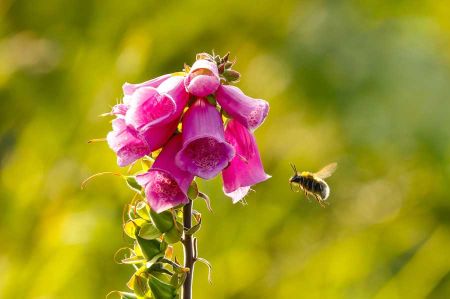Fox Glove on the Eselspfad hiking trail near Billroda
- Written by Portal Editor
Just slightly cloudy skies and not too powerfully warm sunshine had once again tempted us to hike to the forest swimming pool near Rastenberg, which we wanted to reach via the now well-signposted donkey path above Billroda.
Coming from there it was initially quite steep up the ridge, where some felled trees blocked the hiking trail. A little later we came across a roebuck, surprised as we were, who was crossing the path just a few meters in front of us. Arrived at the donkey path, which is actually just a few hundred meters long path that leads steeply down into the valley to the forest road to Rastenberg. We had already walked the path several times, as both the view from here and the flora on the path are simply impressively beautiful. Today, at the beginning of June, we came across the foxglove, which was splendidly in bloom.
Fascinatingly beautiful flowers and so poisonous: the foxglove
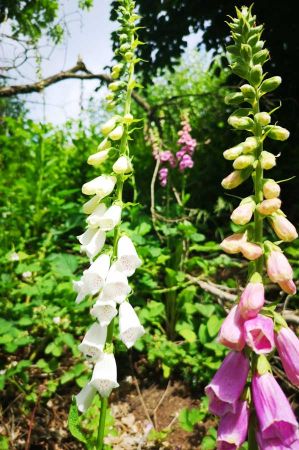 All parts of the red foxglove plant are highly toxic. Eating just two to three foxglove leaves can be fatal. Fortunately, due to the bitter taste of the plant parts, poisoning rarely occurs at adults, and children should be trained at an early stage. Planting in home gardens is also quite controversial for these reasons. The first signs of poisoning are nausea, vomiting, ringing in the ears, dizziness and a drop in heart rate below 50 beats per minute. The red foxglove was voted poisonous plant of the year in 2007.
All parts of the red foxglove plant are highly toxic. Eating just two to three foxglove leaves can be fatal. Fortunately, due to the bitter taste of the plant parts, poisoning rarely occurs at adults, and children should be trained at an early stage. Planting in home gardens is also quite controversial for these reasons. The first signs of poisoning are nausea, vomiting, ringing in the ears, dizziness and a drop in heart rate below 50 beats per minute. The red foxglove was voted poisonous plant of the year in 2007.
The different, sometimes almost endearing names for the red foxglove still lead to misunderstandings: cinquefoil, foxweed, gayweed, our dear woman's glove, forest bell are the most important terms for the red foxglove (Digitalis purpurea).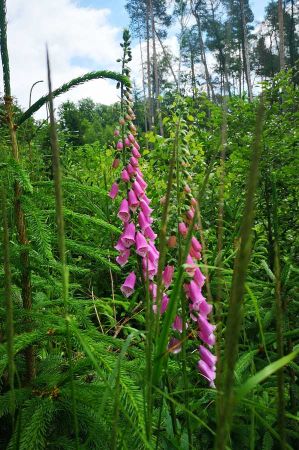 The so different names of the red foxglove already indicate its widespread distribution, because the plant is native to Western Europe as well as Southern, Central and Northern Europe and Morocco. In North and South America the foxglove has been introduced in some areas. In Germany it has its natural distribution area as far as the Harz Mountains and the Thuringian Forest, but today it occurs overgrown throughout the country.
The so different names of the red foxglove already indicate its widespread distribution, because the plant is native to Western Europe as well as Southern, Central and Northern Europe and Morocco. In North and South America the foxglove has been introduced in some areas. In Germany it has its natural distribution area as far as the Harz Mountains and the Thuringian Forest, but today it occurs overgrown throughout the country.
The red foxglove can be found scattered but sociable on clearcuts, especially in the mountains, on forest paths and in forest clearings. It prefers fresh, low-lime, acidic, loose, humus-rich soil in sunny to partially shaded locations.
This striking plant with its magnificent flowers was not given great importance in the Middle Ages or in ancient times. A recipe collection in Welsh from the 12th or 13th century mentions an external use of the leaves for the first time.
The thimble has long been disregarded in medicine
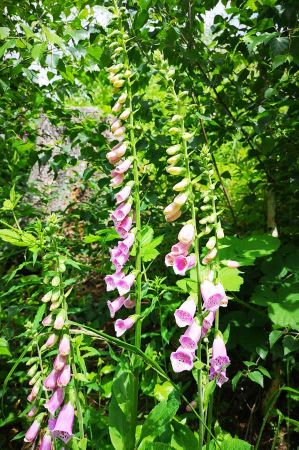 At that time, however, it was already being used in Ireland, combined with magical customs, it should help against the “evil eye”, comparable to the blue glass eye in Turkey.
At that time, however, it was already being used in Ireland, combined with magical customs, it should help against the “evil eye”, comparable to the blue glass eye in Turkey.
The English used the plant as an emetic, to promote expectoration in bronchitis and around 1700 AD even against consumption. In 1748, experiments by the Académie Française showed that after foxgloves were fed to turkeys, their hearts, livers, gall bladder and lungs had shrunk. This meant that the English also used the thimble less often.
But how can it be otherwise, because a poison can also be a cure on the other hand. The red foxglove has long been known in folk medicine as a remedy for heart failure and has even been used medicinally since the late 18th century. The active ingredients in foxglove are cardiac glycosides, which today are predominantly obtained from woolly foxgloves. Cardiac glycosides stimulate the weakened heart muscle to contract more strongly again. In the therapeutic use of Digitalis, the heart rate lowering effect of Digitalis is more and more in the foreground compared to strengthening the cardiac output.
Healing effects discovered by accident
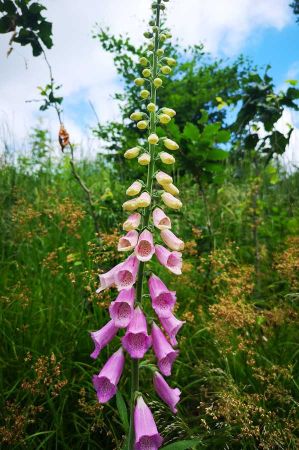 It was not until the English doctor William Withering used an old family recipe for the treatment of dropsy in 1775 and successfully used the leaves of the red foxglove to treat water retention caused by a weak heart. Allegedly, the wife of one of his patients confessed to him that she had asked a herbalist for help. However - as the legend claims - the herbalist did not want to reveal the name and place of growth of the plant to him; he had her observed and found that the herbal woman's elixir contained digitalis. From 1776 to 1779, Withering conducted a series of experiments on dozen of his cardiac patients. On the basis of his observations, he also concluded that the phytotoxin of the thimble accumulated in the body, as the effect of the drug increased with prolonged administration. In 1785 he published his famous treatise "An account of the Foxglove and its medical uses".
It was not until the English doctor William Withering used an old family recipe for the treatment of dropsy in 1775 and successfully used the leaves of the red foxglove to treat water retention caused by a weak heart. Allegedly, the wife of one of his patients confessed to him that she had asked a herbalist for help. However - as the legend claims - the herbalist did not want to reveal the name and place of growth of the plant to him; he had her observed and found that the herbal woman's elixir contained digitalis. From 1776 to 1779, Withering conducted a series of experiments on dozen of his cardiac patients. On the basis of his observations, he also concluded that the phytotoxin of the thimble accumulated in the body, as the effect of the drug increased with prolonged administration. In 1785 he published his famous treatise "An account of the Foxglove and its medical uses".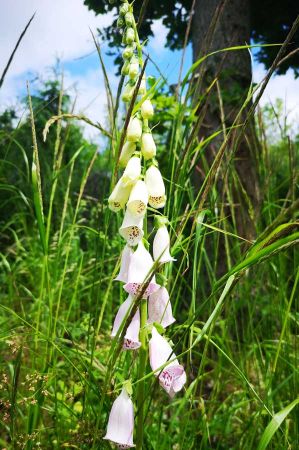 However, this form of therapy did not catch on initially, and it was just after 1850 that digitalis was prescribed more frequently. The research by the French doctor Drebeyne (1786–1867), who found out that digitalis not only has a diuretic effect, but also strengthens the heart's activity, contributed to this. The chemist Nativelle was then able to isolate the active ingredient in 1868. Further pharmacological investigations in the second half of the 19th century then led to the determination of a number of other active ingredients in foxglove species related to the red foxglove. It was also discovered that plant species from other families also contained substances that act on the heart - so-called digitaloids. The plant species in which comparable active ingredients were found included the lily of the valley, the oleander and the Christmas rose. Just the sea onion counted among the medicinal plants discovered as a result of withering's investigations, among the species that were already known to ancient medicine. In 1874, Oswald Schmiedeberg (1838–1921) succeeded in obtaining digitoxin as the first pure glycoside.
However, this form of therapy did not catch on initially, and it was just after 1850 that digitalis was prescribed more frequently. The research by the French doctor Drebeyne (1786–1867), who found out that digitalis not only has a diuretic effect, but also strengthens the heart's activity, contributed to this. The chemist Nativelle was then able to isolate the active ingredient in 1868. Further pharmacological investigations in the second half of the 19th century then led to the determination of a number of other active ingredients in foxglove species related to the red foxglove. It was also discovered that plant species from other families also contained substances that act on the heart - so-called digitaloids. The plant species in which comparable active ingredients were found included the lily of the valley, the oleander and the Christmas rose. Just the sea onion counted among the medicinal plants discovered as a result of withering's investigations, among the species that were already known to ancient medicine. In 1874, Oswald Schmiedeberg (1838–1921) succeeded in obtaining digitoxin as the first pure glycoside.
Please also read:
Bad Bibra - Finne Kneipp cures and cycling
Hike along the Kaiserweg from Billroda to Lossa
Hike over the Finne coming from Billroda
-
 Red thimble on the wayside near Billroda
Red thimble on the wayside near Billroda
Red thimble on the wayside near Billroda
Red thimble on the wayside near Billroda
-
 Red thimble on the wayside near Billroda
Red thimble on the wayside near Billroda
Red thimble on the wayside near Billroda
Red thimble on the wayside near Billroda
-
 Red thimble on the wayside near Billroda
Red thimble on the wayside near Billroda
Red thimble on the wayside near Billroda
Red thimble on the wayside near Billroda
-
 Red thimble on the wayside near Billroda
Red thimble on the wayside near Billroda
Red thimble on the wayside near Billroda
Red thimble on the wayside near Billroda
-
 Red thimble on the wayside near Billroda
Red thimble on the wayside near Billroda
Red thimble on the wayside near Billroda
Red thimble on the wayside near Billroda
-
 Red thimble on the wayside near Billroda
Red thimble on the wayside near Billroda
Red thimble on the wayside near Billroda
Red thimble on the wayside near Billroda
-
 Red thimble on the wayside near Billroda
Red thimble on the wayside near Billroda
Red thimble on the wayside near Billroda
Red thimble on the wayside near Billroda
-
 Red thimble on the wayside near Billroda
Red thimble on the wayside near Billroda
Red thimble on the wayside near Billroda
Red thimble on the wayside near Billroda
-
 Red thimble on the wayside near Billroda
Red thimble on the wayside near Billroda
Red thimble on the wayside near Billroda
Red thimble on the wayside near Billroda
https://www.alaturka.info/en/life/flora/5384-fox-glove-on-the-eselspfad-hiking-trail-near-billroda?tmpl=component&print=1&layout=default#sigProIdc78b747c2b
